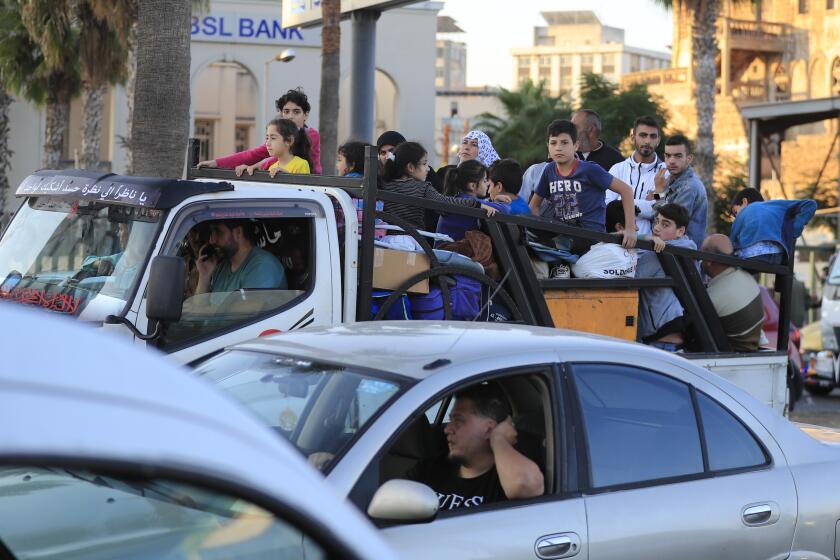Seven key questions about the Iran nuclear negotiations
Reporting from Lausanne, Switzerland — The U.S. and five other world powers have negotiated with Iran almost nonstop for 18 months in an effort to subject that country’s nuclear program to international controls.
On Thursday, they reached a tentative agreement and Iran accepted limits on its nuclear efforts. In return, the Middle East country will receive relief from some economic sanctions imposed by the U.S., Europe and the United Nations.
The tentative deal is complex, and negotiators have emphasized that no provisions are agreed to until a final agreement has been reached. U.S. officials contend that the deal could look quite different from what’s been reported publicly so far. Here are some of the major issues:
How many centrifuges would Iran be allowed to operate?
Centrifuges are complex machines that spin uranium gas at high speeds to separate fissionable uranium from nonfissile material. The enriched uranium they produce can be used to fuel reactors to generate power or, if enriched to a high level, as fuel for a bomb.
Iran is known to have about 19,000 IR-1 centrifuges, often referred to as first-generation machines because they are less sophisticated than newer models. They are installed at two uranium-enrichment facilities at Natanz and Fordow. Under the tentative deal, Iran has agreed to reduce by about two-thirds its installed centrifuges to 6,104, with 5,060 of these enriching uranium for 10 years.
Last summer, Iran’s supreme leader, Ayatollah Ali Khamenei, said the country ultimately needed the enrichment capacity of 190,000 first-generation centrifuges to fuel a domestic nuclear-power industry.
Israeli Prime Minister Benjamin Netanyahu has long demanded that Iran’s enrichment facilities be entirely dismantled, although last month, he signaled for the first time that he could accept Tehran being allowed a very limited enrichment capacity.
Iran is not to be allowed to deploy newer centrifuges that can enrich uranium more quickly.
What other restrictions would be placed on Iran’s nuclear stockpile?
Iran’s stockpile of low-enriched uranium would be cut sharply, from the approximately 17,600 pounds it has now to about 660 pounds under the tentative deal. Negotiators have discussed shipping much of the material to Russia to limit Iran’s access to it.
The six world powers also want to limit the way Iran’s centrifuges are connected in groups called cascades. Such a move is designed to limit their output.
The overall goal is to limit Iran’s production and stockpiling of enriched uranium so that the country would need 12 months to produce enough fissile material to fuel one bomb. That period is called the “breakout time.” Currently, Iran’s breakout time is estimated to be two or three months.
What sort of nuclear research activities would Iran be barred from conducting?
The six world powers want to restrict Iran’s ability to develop higher-capacity centrifuges, because such devices would allow it to generate more enriched uranium more quickly and shorten the breakout time. This has been a hotly disputed issue because Iran views nuclear research as a point of national pride and says no other country has to live with such restrictions.
In the tentative agreement, Iran has agreed to not conduct research and development associated with uranium enrichment at Fordow for 15 years.
The U.S. and its allies say Iran should be subject to unprecedented restrictions given its history of efforts to evade international nuclear rules.
What sort of monitoring would Iran have to accept?
Almost two-thirds of Fordow’s centrifuges and infrastructure will be removed. The remaining centrifuges will not enrich uranium. All centrifuges and related infrastructure will be placed under the International Atomic Energy Agency (IAEA) monitoring.
Western officials want to impose tougher monitoring than any country has ever faced, and they say they want this scrutiny to last indefinitely. They want regular access to all of Iran’s enrichment sites and also to uranium mines and all other sites related to nuclear production. They also want quick access to Iran’s military sites.
How long would the deal last?
The deal will last about 10 years, with restraints on Iran being lifted gradually during an additional period of five or so years. U.S. officials say, however, that rigorous monitoring of Iran would last indefinitely, and they hint that other restrictions might remain in place after the 10-year period.
Long-lasting restrictions could be resisted strongly by Iran because its leadership has promised the public repeatedly that before long, the country will be treated like any other nation that has signed the Nuclear Nonproliferation Treaty. Last year, Iran was insisting that the deal could last only about seven years.
How quickly would economic sanctions be lifted?
Some sanctions would be eased quickly, including some imposed by the European Union and perhaps some U.S. sanctions that President Obama can waive using his executive authority. But the world powers want to keep substantial sanctions in place for years, lifting them as Iran proves that it will live up to the terms of the deal.
Iran needs enough sanctions relief right away to generate the kind of economic boost that its public hopes to see from the deal. Iran has also been pushing for quick relief from United Nations sanctions. Those are less onerous than U.S. or European sanctions but are important in part because they lend international legitimacy to the sanctions imposed by the Western countries.
What’s the bottom line on whether the deal is good or not?
The argument from the Obama administration is that a negotiated deal that limits what Iran can do and imposes strict monitoring is the best approach considering the alternatives.
Preventing Iran from gaining nuclear capability for more than 10 years provides more security than a military strike, they say. A military strike, even if it worked, would set the Iranian program back only by two or three years, after which Iran would probably halt all U.N. inspections and go full tilt to obtain the bomb, U.S. officials say.
A negotiated deal would also accomplish more than additional sanctions, the White House contends. Officials note that Iran’s leaders have continued to expand the nuclear program even as the U.S., Europe and the U.N. have imposed crippling sanctions in the last few years.
Many members of Congress, the Israeli government and some outside experts, however, dispute the Obama administration’s argument about sanctions. They contend that further blows to Iran’s economy would force the country to make more concessions.
Richter reported from Lausanne and Lee from Los Angeles.
For more on U.S. foreign policy, follow @RichtPau on Twitter.
More to Read
Sign up for Essential California
The most important California stories and recommendations in your inbox every morning.
You may occasionally receive promotional content from the Los Angeles Times.












